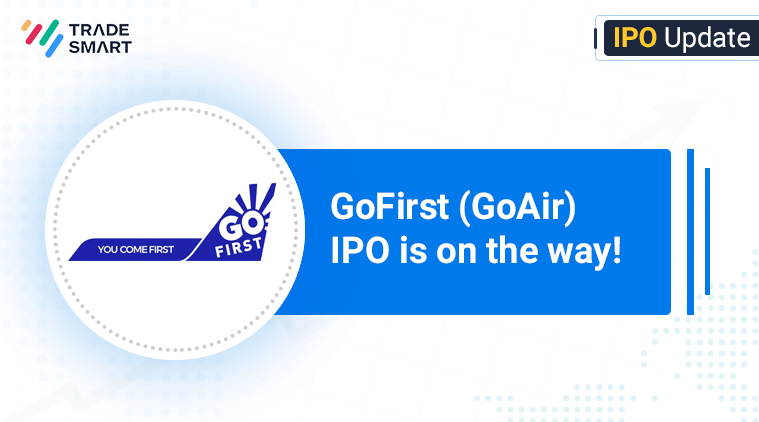
GoFirst (GoAir) IPO Launch Date & Price
GoAir, now rebranded as GoFirst, is expected to launch its initial public offering (IPO) in August 2021. In May 2021, the airline filed its draft red herring prospectus (DRHP) with the Securities and Exchange Board of India (SEBI). Below are the key highlights of the company’s IPO, its business, and the process to apply to GoAir IPO.
IPO Information
Morgan Stanley and Citigroup are managing the GoAir IPO. The company aims to raise ₹3,600 crores through this IPO and utilise its proceeds mainly towards debt repayment. Here is the breakup of its proposed use of the net proceeds from the IPO. The net proceeds are calculated as gross proceeds less issue-related expenses.
| Use of Funds | Amount (in ₹Crores) |
| Prepaying or repaying some or all of the company’s outstanding debt | 2,015 |
| Replacing letters of credit issued to some of its aircraft lessors | 279 |
| Repaying some or all of its dues to Indian Oil Corporation (IOC) for fuel supplies | 254 |
| General corporate purposes | To be determined later |
The company will finalise the amount to be used for general corporate purposes after determining the issue price. This amount will not be more than 25% of the gross proceeds of the GoAir IPO.
About GoAir
GoAir is an ultra-low-cost carrier (“ULCC”). The budget airline, which started its operations in the year 2005, targets young Indians and Micro, Small, and Medium Enterprises (MSMEs) as customer segments.
Background of Management and Promoters
The company’s promoters are associated with the Wadia Group, one of India’s oldest conglomerates. Four companies in the Wadia Group are listed on Indian stock exchanges, including Britannia, Bombay Burmah, Bombay Dyeing, and NPL, which manufactures hydrogen peroxide. The company’s Vice Chairman Ben Baldanza was the CEO of Sprint Airlines in the US.
Passenger Volume
The Indian aviation market is the fastest-growing aviation market globally. In 2020, the market served 208 million passengers against 76 million passengers in 2010.
Between 2010 and 2020, India’s travel market has grown as follows:
| Market | CAGR |
| Domestic | 11.9% |
| International | 10.8% |
In fiscal 2020, the company’s domestic market share in the airline industry was 10.8% compared to 8.8% in 2018. In fiscal 2020, the company’s passenger volumes were 16.2 million passengers, growing at a CAGR of 22.4% from 10.8 million passengers in fiscal 2018.
As of January 31, 2020, the company covered 28 domestic and 9 international destinations.
Performance Against Peers
During fiscal 2020, the company had high aircraft utilisation with average utilisation of 12.9 hours per day. The company had a high load factor (seats sold by the airline as a percentage of its available seats) of 88.9%. The company’s focus on operational efficiency and reliability helped it achieve several milestones among all airlines in the country, including:
- Best on-time performance for 15 consecutive months (from September 2018 to November 2019)
- Least cancellations (0.3%) for fiscal 2021 (as of January 31, 2021)
- The lowest number of customer complaints (0.3 per 10,000 customers) in fiscal 2021 (against an industry average of 1.0 per 10,000 customers)
Over the years, the company has also received several awards, including:
- Best cabin service in Central Asia in 2020
- Best seat comfort in Central Asia in 2020
Current Financial Situation
Here is a summary of the company’s income and losses as per the information shared in the DRHP. All figures are in ₹ crores.
| Nine months ended, December 31,2020 | FY 2020 | FY 2019 | FY 2018 | |
| Total Income | 1, 438 | 7,258 | 5,936 | 4,601 |
| Profit/Loss for the period | (470) | (1,270) | (386) | (31) |
Presently, the company’s total borrowings stand at ₹1,838 crores.
Fleet Information
As of February 10, 2021, the company had a fleet inventory of 56 aircrafts. Out of these, 46 were A320 NEO models, and 10 were A320 CEO models. The average age of the company’s aircraft is 3.7 years. According to the Centre for Asia Pacific Aviation (CAPA), this is the youngest average fleet among all Indian low-cost carriers.
The company currently has an order book for 98 A320 NEO aircraft. It expects to take the delivery of additional A320 NEOs as follows:
| Fiscal | Expected Delivery |
| 2022 | 8 |
| 2023 | 14 |
| 2024 | 14 |
A320 NEOs offer 17-20% more fuel efficiency than A320 CEOS. By 2024, the company expects its entire fleet to comprise A320 NEOs.
Aircraft Uniformity
The company employs a single type of aircraft across its entire fleet. The company’s light, fuel-efficient, and uniform fleet with common OEM suppliers have helped in reducing its operational costs. A consistent fleet also allows it to use any aircraft for any route, thus increasing the flexibility of its flight scheduling. Uniformity also helps GoAir lower its operational costs due to standard maintenance procedures and inventories of spare parts.
Using a single type of aircraft also allows the company to standardise its requirements for pilots and maintenance teams. This uniformity facilitates easier resource availability while removing training requirements for engineers and the crew.
Steps Taken to Counter the Impact of COVID-19
The company has taken several measures to deal with the adverse impact of COVID-19 on the airline industry. GoAir’s steps to save cash included negotiating with their aircraft lessors to delay lease payments. The airline has negotiated contracts across the business to reduce their costs and optimise workforce costs with a variable pay structure.
The company built its cash reserves by operating over 600 international charters to get Indians back home from various parts of the world. In February 2020, the company discontinued outsourcing its cargo facility for domestic flights and started to handle cargo on its own. This move helped the airline increase its share of cargo revenues.
GoAir restarted its operations in a planned way based on demand and profitability. On December 31, 2020, the company’s departures stood at nearly 63% of pre-COVID levels.
Future Strategy
The company aims to achieve its goal of reducing or restraining its unit costs by leveraging the fuel efficiency of its A320 NEO fleet. If the government brings aircraft fuel under GST, as suggested by some media reports, it will help in reducing the company’s fuel costs. The airline’s goal of having its entire fleet as A320 NEOs will help reduce maintenance costs. GoAir also aims to reduce its other operating costs through improved aircraft leasing and better pricing.
GoAir aims to expand its network to high revenue international markets like the Middle East and Southeast and high-demand Indian markets like Srinagar, Leh, Ranchi, Goa, etc.
The company is focused on providing differentiation to customers through digital transformation. Some examples of service differentiation include providing auto check-in and using biometrics to facilitate paperless travel.
In the future, GoAir aims to grow its ancillary revenue as a percentage of its operating revenue. Sources of ancillary revenue include cargo services, seat selection, pre-booked meals, among others.
Risk Factors
The various risk factors listed in the DRHP include the adverse impact of COVID-19 on GoAir’s business. The company has suffered net losses due to the pandemic. COVID-19 also affected its ability to make payments under some of its aircraft lease and supply agreements. It has received some notices for delayed payments or non-payments. While the company had lower fuel, human resources, and airport operating costs due to COVID-19, it continued to incur fixed costs.
GoAir IPO Launch Date
GoAir IPO’s launch date is expected in August. The company has not announced a listing date yet.
GoAir IPO Price
The company has also not yet announced GoAir IPO’s expected share price range.
How To Apply for GoAir IPO With TradeSmart?
If you do not have a trading and Demat account, you can open one with TradeSmart and apply for the GoAir IPO.
If you have an account with TradeSmart, you can apply for the GoAir IPO in a few simple steps.
- Step 1
Log in to TradeSmart, and select IPO under the ‘Portfolio’ menu. You can find the GoAir IPO under the current and upcoming IPO section.
- Step 2
Click on ‘BID’ to participate in GoAir’s IPO.
- Step 3
Enter your UPI ID. Make sure your UPI ID is mapped to your personal bank account. Your IPO application will get rejected if you enter a UPI ID linked to someone else’s bank account.
- Step 4
Place your bid in multiples of the lot size. For example, if the lot size is 20, you need to enter a quantity in multiples of 20 (i.e., 20, 40, 60, and so on). If you want to apply for the GoAir IPO at the cut-off price, click on the ‘Use Cutoff price of’ checkbox. Cut-off price could be any price within the price band.
Merchant bankers determine the cut-off price for an IPO after they have processed all applications. If you are ready to pay any price within the price band, you should click on this checkbox. If you have your price limit, you should enter the value in the ‘Price’ field. Upon completing these steps, click on the checkbox, confirming you have read the Red Herring Prospectus (RHP) and other documents.
- Step 5
On your UPI app, you will get a mandate request confirming the blocking of funds from your account towards the IPO.
- Step 6
The stock exchange will send you an SMS acknowledging your application. Typically, the exchange sends the SMS at the end of the day. You can also check the My Applications tab on TradeSmart to check the status of your bid.












[…] Go Airlines IPO […]